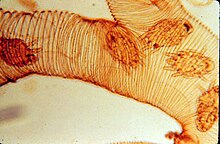Acarapis woodi
| Acarapis woodi | |
|---|---|

| |
| Scientific classification | |
| Kingdom: | |
| Phylum: | |
| Class: | |
| Subclass: | |
| Order: | |
| Family: | |
| Genus: | |
| Species: | A. woodi
|
| Binomial name | |
| Acarapis woodi (Rennie, 1921)
| |
Acarapis woodi (honey bee tracheal mite) is an internal parasite of honey bees,[1] originally described from the Isle of Wight.[2] Acarapis woodi mites live and reproduce in the tracheae of the bees. These mites are arachnids like spiders.[2] The female mite attaches 5–7 eggs to the tracheal walls, where the larvae hatch and develop in 11–15 days to adult mites.[2] The mites parasitize young bees up to two weeks old through the tracheal tube openings. There, they pierce the tracheal tube walls with their mouthparts and feed on the haemolymph of the bees. More than a hundred mites can populate the tracheae and weaken the bees. The mites are generally less than 175 micrometres (0.007 in) long, and can only be seen and identified under a microscope.[2]
Other mites similar in appearance include Acarapis externus and Acarapis dorsalis.
References
- ^ ""Tracheal mites" Tarsonemidae". Agricultural Research Service, United States Department of Agriculture. February 18, 2005. Retrieved March 10, 2011.
- ^ a b c d H. A. Denmark, H. L. Cromroy & Malcolm T. Sanford (2000). "Honey bee tracheal mite, Acarapis woodi". Featured Creatures. University of Florida. Retrieved March 10, 2011.
